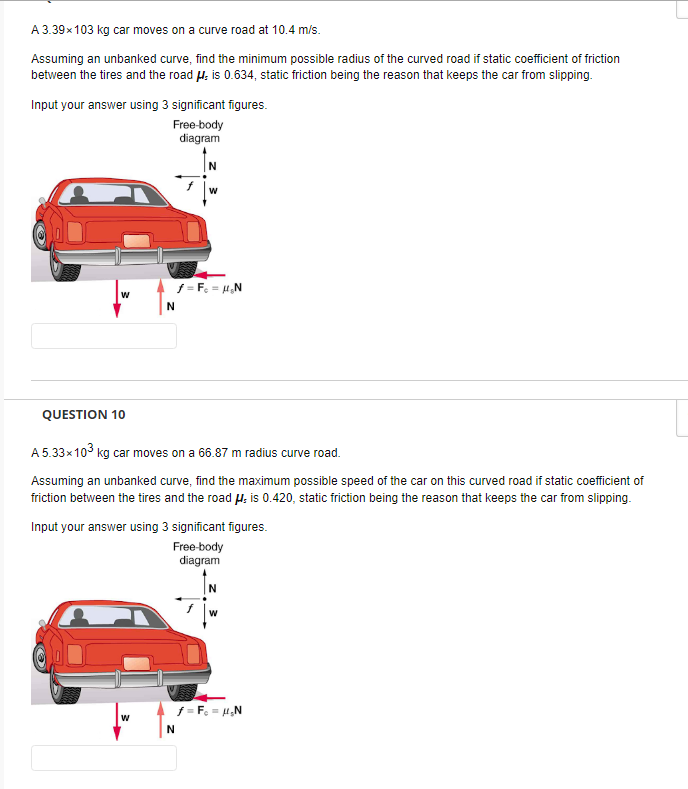A 3.39x103 kg car moves on a curve road at 10.4 m/s. Assuming an unbanked curve, find the minimum possible radius of the curved road if static coefficient of friction between the tires and the road µ, is 0.634, static friction being the reason that keeps the car from slipping. Input your answer using 3 significant figures. Free-body diagram 1-F. = H,N N QUESTION 10 A 5.33x103 kg car moves on a 66.87 m radius curve road. Assuming an unbanked curve, find the maximum possible speed of the car on this curved road if static coefficient of friction between the tires and the road u, is 0.420, static friction being the reason that keeps the car from slipping. Input your answer using 3 significant figures. Free-body diagram 1 = F. = H,N
A 3.39x103 kg car moves on a curve road at 10.4 m/s. Assuming an unbanked curve, find the minimum possible radius of the curved road if static coefficient of friction between the tires and the road µ, is 0.634, static friction being the reason that keeps the car from slipping. Input your answer using 3 significant figures. Free-body diagram 1-F. = H,N N QUESTION 10 A 5.33x103 kg car moves on a 66.87 m radius curve road. Assuming an unbanked curve, find the maximum possible speed of the car on this curved road if static coefficient of friction between the tires and the road u, is 0.420, static friction being the reason that keeps the car from slipping. Input your answer using 3 significant figures. Free-body diagram 1 = F. = H,N
University Physics Volume 1
18th Edition
ISBN:9781938168277
Author:William Moebs, Samuel J. Ling, Jeff Sanny
Publisher:William Moebs, Samuel J. Ling, Jeff Sanny
Chapter6: Applications Of Newton's Laws
Section: Chapter Questions
Problem 71P: If a car takes a banked curve at less than the ideal speed, friction is needed to keep It from...
Related questions
Question
make answer visible and bold

Transcribed Image Text:A 3.39x103 kg car moves on a curve road at 10.4 m/s.
Assuming an unbanked curve, find the minimum possible radius of the curved road if static coefficient of friction
between the tires and the road H; is 0.634, static friction being the reason that keeps the car from slipping.
Input your answer using 3 significant figures.
Free-body
diagram
w
f = F. = H,N
N
QUESTION 10
A 5.33x103 kg car moves on a 66.87 m radius curve road.
Assuming an unbanked curve, find the maximum possible speed of the car on this curved road if static coefficient of
friction between the tires and the road H.; is 0.420, static friction being the reason that keeps the car from slipping.
Input your answer using 3 significant figures.
Free-body
diagram
f = F. = H,N
w
Expert Solution
This question has been solved!
Explore an expertly crafted, step-by-step solution for a thorough understanding of key concepts.
Step by step
Solved in 3 steps

Knowledge Booster
Learn more about
Need a deep-dive on the concept behind this application? Look no further. Learn more about this topic, physics and related others by exploring similar questions and additional content below.Recommended textbooks for you

University Physics Volume 1
Physics
ISBN:
9781938168277
Author:
William Moebs, Samuel J. Ling, Jeff Sanny
Publisher:
OpenStax - Rice University

University Physics Volume 1
Physics
ISBN:
9781938168277
Author:
William Moebs, Samuel J. Ling, Jeff Sanny
Publisher:
OpenStax - Rice University